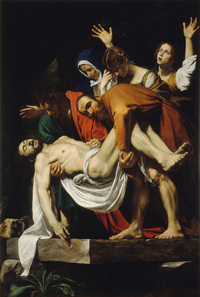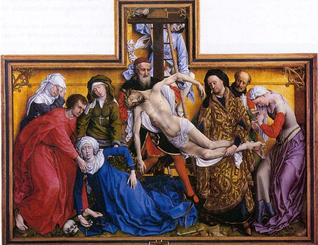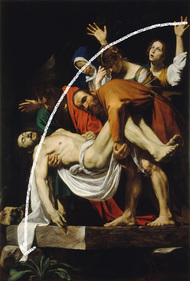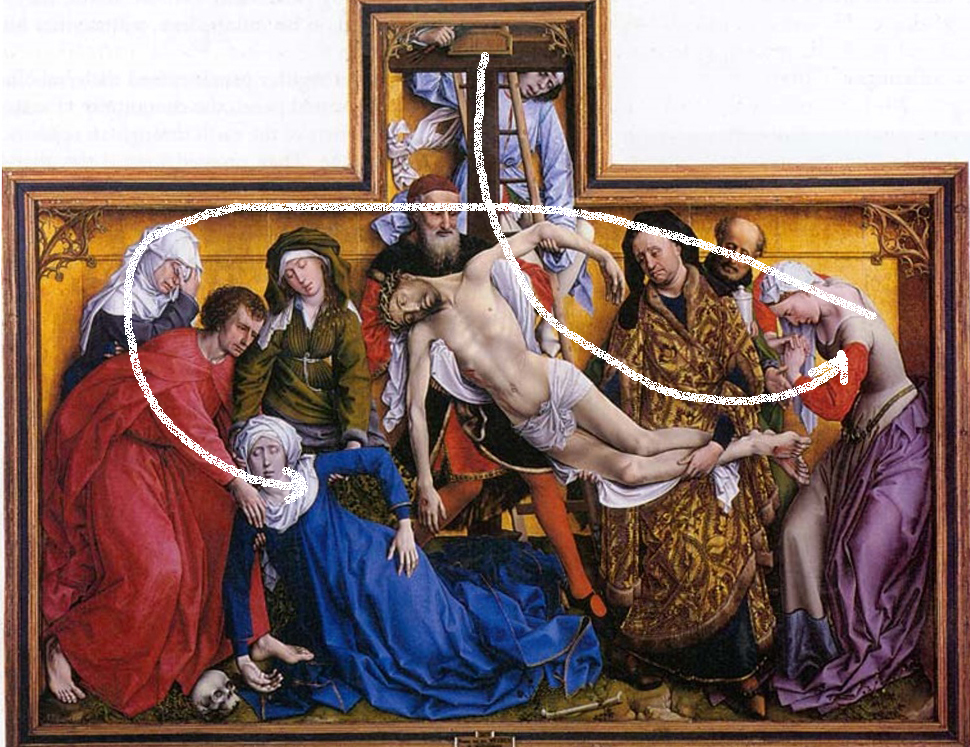Now that we’re familiar with the six-step process of the ©Follow Your Eyes Method, let’s use it to compare two famous paintings with the same subject. In these two paintings the artists are depicting a scene following the crucifixion of Christ. It is commonly referred to as the Deposition or Lamentation and is the 13th Station of the Cross.
1. Note your first impression of the image in terms of an idea or a feeling.
These paintings are about death and grief. The Caravaggio painting has the feeling of flight, whereas the Van der Weyden feels congested and densely packed.
2. Note the orientation and shape of the picture plane.
Caravaggio composed his subject in a vertical rectangle emphasizing vertical movement. Our eyes travel from the upper right in an arc following the repeated pattern of heads and outstretched hands down to the lower left of the picture plane.
Van der Weyden composed his painting in a horizontal rectangle emphasizing lateral movement. His panel has an inverted T shape, which is mirrored in the upright T shape of the cross that breaks the upper frame in the center. Our eyes start at the top center in this irregular protrusion and drop into the inverted T via the stem of the cross and ladder angling to the right. Here we begin to follow the repeated pattern of heads from right to left.
Although these two compositions differ in orientation it is pretty interesting to note that they both use right-to-left movement, which is contrary to our perceptual tendency to read images from left-to-right. They “go against the tide,” so to speak, and thereby effectively create the sensation of struggle.
These paintings are about death and grief. The Caravaggio painting has the feeling of flight, whereas the Van der Weyden feels congested and densely packed.
2. Note the orientation and shape of the picture plane.
Caravaggio composed his subject in a vertical rectangle emphasizing vertical movement. Our eyes travel from the upper right in an arc following the repeated pattern of heads and outstretched hands down to the lower left of the picture plane.
Van der Weyden composed his painting in a horizontal rectangle emphasizing lateral movement. His panel has an inverted T shape, which is mirrored in the upright T shape of the cross that breaks the upper frame in the center. Our eyes start at the top center in this irregular protrusion and drop into the inverted T via the stem of the cross and ladder angling to the right. Here we begin to follow the repeated pattern of heads from right to left.
Although these two compositions differ in orientation it is pretty interesting to note that they both use right-to-left movement, which is contrary to our perceptual tendency to read images from left-to-right. They “go against the tide,” so to speak, and thereby effectively create the sensation of struggle.





 RSS Feed
RSS Feed